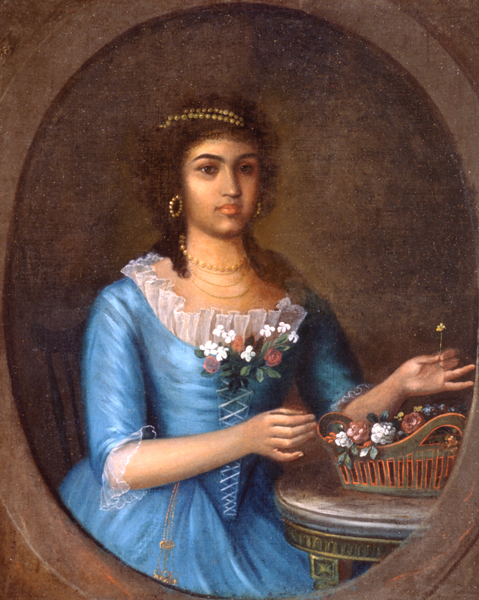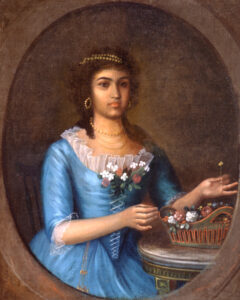Women in Colonial Louisiana
Women constituted a valuable asset in colonial Louisiana.

Courtesy of Louisiana State Museum
Marianne Celeste Dragon. Salazar, Jose
Women constituted a valuable, yet scarce, asset in colonial Louisiana (1699–1803, and until 1810 for West Florida, or the Florida Parishes). Throughout the colonial period the population—which consisted of Native American, African, European, and British inhabitants—reflected a marked degree of sexual imbalance that did not equalize until the last decades of the nineteenth century. The shortage of female settlers deeply concerned those in charge of colonization, but initial attempts to provide Louisiana men with marriageable women frequently failed. Regardless of their status or ethnic background, colonial Louisiana women endured difficult lives as they negotiated the dangers of the frontier: scarce supplies, hostile environment, and the hard physical labor that came with transforming the wilderness into a home. Even the most elite women succumbed to the diseases that flourished in Louisiana’s climate. However, the women who eventually came to Louisiana influenced the colony not only in terms of their impact on population growth, but in their contributions to the nascent society and their ability to assimilate and transfer cultural patterns that are still evident today.
Importance of Women in the Louisiana Colony
In 1699, France established Louisiana primarily as a military outpost, and later efforts by Spanish and British regimes also focused on Louisiana’s value as a strategic asset. Therefore, soldiers, administrators, and support personnel, not families, formed the largest percentage of Louisiana colonists. Subsequent efforts by French, Spanish, and British governments to bring in family groups sometimes succeeded, but not in sufficient numbers to create a growing, productive colony based on natural reproduction to mirror the success of the Atlantic seaboard colonies. To support the military presence, Louisiana needed to increase its population and produce goods for market. These objectives required the presence of families.
The 1726 French census of settlements within the current state of Louisiana reveals a ratio of 2.5 adult men for every adult woman. Colonial officials were well aware of the success enjoyed by the colonizers of the eastern seaboard colonies, whose settlers consisted primarily of family groups. Indeed, some of the most successful immigrants to colonial Louisiana were the Germans, who came as families and whose “German Village” (German Coast) settlement consisted of an equal number of women and men by 1726. Officials also understood the civilizing influence women could exert on unruly, male-dominated settlements. At the most basic level, the men who populated colonial Louisiana desired companions and helpmeets capable of softening the rough edges of frontier life. Louisiana needed women.
Native American Women
From the beginning of colonization efforts, Europeans encountered Native American women who participated in the support of their own villages, as well as in trade, political, and personal relationships with colonizers. In many of these societies, some of which adhered to matrilineal inheritance practices, women owned the land and took primary responsibility for planting and harvesting crops. During the French colonial period (1682–1762), French trappers and traders (coureurs des bois) sometimes formed relationships with Native American women, often in order to solidify trade relationships with their villages. Native American women sold provisions, baskets, and other goods to neighboring European settlements, and frequently served as translators between chiefs and colonial officials. Attempts to enslave Native Americans resulted in marginal success. While the number of enslaved Native Americans never approached the number of enslaved Africans in Louisiana, some women did endure lives that mirrored the experiences of enslaved Africans, and women constituted the majority of enslaved Native Americans.
European and British American Women
During the French colonial period, the Company of the Indies began to assemble and transport groups of young women to Louisiana. The first group arrived aboard the ship Le Pélican in July 1704, and by September most had found husbands. The company made numerous attempts to populate Louisiana by periodically transporting groups of women, some of whom were criminals and prostitutes. In general, this experiment failed in its effort to provide a sufficient number of marriageable young women to colonial men. In contrast, the casket girls, or “filles à la casette,” groups of modest young French women so called because of the small chests in which their belongings were shipped, proved to be the most notable success. Upon their arrival in Louisiana in 1728, the Ursuline nuns in New Orleans housed and cared for these young women until they found husbands. Today many Louisianans proudly trace their ancestry to these women.
Efforts to populate Louisiana during the Spanish (1763–1783 and 1783–1810 for West Florida) and British (1763–1783) periods focused on a system of generous land grants in an attempt to lure families from the eastern seaboard colonies. These efforts brought more families to the area, but the majority of migrating settlers continued to be male. Between 1778 and 1783, Spain transported approximately two thousand Canary Islanders, now known as Isleños, most of them in family units, to four settlements in southern Louisiana. The Acadians also came in family units from the 1760s to 1780s. However, neither the Spanish nor British made efforts to recruit women as the French had done.
The Ursulines
In 1726 Father Nicolas de Beaubois, a Jesuit priest, recommended that the presence of a contingent of Ursuline sisters would be a beneficial addition to the colonial environment of New Orleans. Company of the Indies officials agreed and entered into a contract with the Ursulines to operate the Royal Hospital, a departure from their traditional mission as educators. To serve the needs of inhabitants who would otherwise be forced to send their daughters back to France for education, the contract also allowed the Ursulines to operate a school for the education of young women and girls. This school served not only the daughters of white European settlers but students of African and Native American descent as well. Along with reading, writing, and mathematics, the school taught sewing, knitting, and additional housekeeping skills. The sisters also housed and schooled orphan girls, most notably the victims of the 1729 Fort Rosalie massacre in Natchez. The Ursuline Academy, which is still in operation today, is the longest continuously operating school for women in the United States.
Enslaved Women and Free Women of Color
Enslaved women, both African and Native American, formed a large percentage of the female population of colonial Louisiana. French colonizers began importing Africans into Louisiana in 1719, and the enslaved population continued to grow throughout the colonial period. Bondswomen performed an almost unlimited variety of tasks within the colony, engaging in domestic work as well as chores in fields, forests, and on docks. Many enslaved Louisiana women participated in the colonial economy and were the primary purveyors of goods and services in the marketplace, a cultural continuity from Africa, where women dominated the markets.
Historian Gwendolyn Midlo Hall has observed that African women influenced culture in Louisiana more than in any other North American colony. Hall identifies the early importation of Wolof women from the Senegal region of West Africa as the primary factor in this synthesis. Wolof women represented the majority of African females in the first years of the Louisiana slave trade, and they were most likely to continue and disseminate cultural practices brought from Africa. As the women who raised their own children as well as those of their owners, Wolof—or Senegal as they were more commonly known in Louisiana—women possessed the ability to pass on these cultural continuities to an expanding number of both African-descended and white children and adults. Perhaps the best-known Wolof legacy is the Bouki-Lapin folktales, the original source of Br’er Rabbit stories. Islamic and Wolof names are prevalent in slave lists; Islam had come to the Senegal region centuries before the European slave trade began.
Perhaps most important for enslaved women and their children, at least one significant aspect of Wolof marriage custom transferred and adapted to Louisiana’s slave society. In Africa an enslaved woman and her children were considered free if she married a free man; in Louisiana the manumission of an enslaved concubine and the mixed-race children of her white companion became common practice. This and the transmission of other marriage and gender practices may be attributed to the interactions of French men and Wolof women that commenced in the seventeenth century in the Senegal region of West Africa and were repeated in Louisiana. According to Hall, the Louisiana Creole language also reflects an African cultural contribution to colonial Louisiana. Indigenous languages such as Bambara, which constitute a part of this mixture of French and African grammar and vocabulary, originated primarily in Senegal, and the creation of Louisiana Creole has been traced to enslaved Africans of Senegalese origin.
Not all women of color in Louisiana were enslaved, however. By exercising opportunities as vendors or by hiring themselves out in other capacities, many enslaved women gained their freedom by self-purchase. Owners manumitted enslaved people for various reasons, and some men who formed interracial relationships freed the children who resulted from these relationships as well as their mothers. Perhaps the best-known of these Louisiana free women of color was Marie Thèrése, better known as Coincoin, matriarch of the Cane River settlement of Creoles of color.
Daily Lives
Although the responsibilities of women in colonial Louisiana varied greatly depending upon their individual circumstances, many aspects of their daily lives were consistent. Only the most elite women, who constituted a small minority, escaped hard physical labor both inside and outside the home, although evidence exists that many participated in the retail trade of luxury goods in order to supplement their husbands’ incomes. Some women came to Louisiana with occupations; one ship’s list names bakers, cooks, knitters, and seamstresses among the women on board. Most families did not own enslaved people or hold indentured servants, which meant the responsibilities of maintaining the home and farm fell to all family members, including mothers and daughters. Even women who had servants worked alongside their laborers, planting and harvesting crops, tending livestock, spinning, sewing, weaving, cooking, doing laundry, and performing the tasks necessary to survive in a society based on subsistence agriculture. Almost all women except the truly elite, enslaved or free, tended homes, crops, and livestock, especially if they lived in rural areas. Louisiana women truly contributed to the development of the colony.
Perhaps the most valuable service performed by the women of colonial Louisiana was their ability to assimilate and transfer culture to subsequent generations. Far more frequently than men, women—either as mothers or caretakers—passed along foodways, religious beliefs, folklore, music, and their own cultural worldviews to the children at their knees. The mother singing a lullaby, the nun teaching a young girl how to pray the rosary or how to knit a stocking, the enslaved housekeeper combining ingredients for a dish or telling a Bouki and Lapin folk tale—all imparted rich and varied cultural components that combined to make Louisiana the unique and culturally vibrant state it is today.
